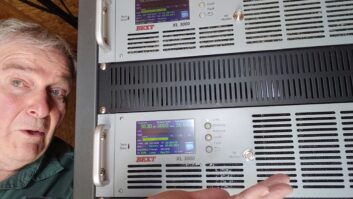With Apologies to Bill Doherty
Your article (“KRLD’s Dougherty Transmitter,” July 1) discussed “the Western Electric 407A2 50 kW water-cooled Dougherty transmitter at KRLD in Dallas.”
When I took my FCC first class radiotelephone test in 1969, I vividly recall — and still think about — not knowing what a Doherty amplifier was. Back then, there was no Internet to search, the test pool was not posted and I could not find out what a Doherty amplifier, circuit or transmitter was. Not one of my engineering friends had heard of it; however none of us had ever had the fun of working with an old W-E transmitter.

KRLD’s Doherty Transmitter.
These days, a quick Google search turns up hundreds of thousands of hits for both “Doherty” and “Dougherty.” But you’ve got to be careful; just as the Internet is full of information, it’s also full of misinformation.
From what I can tell, the correct spelling is Doherty, named after William H. Doherty, 1907–2000. Several well-respected references seem to bear out that spelling.
Bob Meister
Hamden, Conn.
Remarkable Performance
You spelled Bill Doherty’s name wrong! (“KRLD’s Dougherty Transmitter,” July 1.) You can find out more about him at his Wikipedia listing, under William H. Doherty.
I have seen several recent articles regarding “load pulling” amplifiers for digital use that employ the Doherty principles.
The WECO Dohertys, like the later CEMCO ones, were capable of astounding performance (even though they did chew up AC power). Many of them would not only pass the old FM proof requirements for distortion and frequency response, but they could, if properly adjusted, easily create 150 percent or more positive modulation peaks.

A 50 kW Doherty is visible at KIRO in a 1940s photo. James B. Hatfield Sr. sits at the control console.
The most astounding Dohertys ever made were designed by Bill Brennan (for WBAM, WAPE and WVOK) who, like Doherty, was a Harvard graduate. The transmitters he designed and built were among the few “handmade” 50s. The other notable example I am aware of was the KFBK Chireix “outphasing” design (renamed Ampliphase by RCA).
Attached is another nifty picture of a first-generation WECO 50 kW Doherty, at KIRO, complete with National Guardsmen in tin hats and James B. Hatfield (Sr.) sitting at the control console.
This was taken by a commercial photographer and has his stamp on the back so it is an original print but the photography studio has long since vanished. The photo is undated but is obviously sometime in the 1942–1945 period, probably early on.
KIRO was at that time the most powerful station in the Northwest and certainly was considered to be a critical communications facility. It’s on Maury Island, not exactly an area lending itself to high security. Hence the gentlemen in the tin hats, who I am told were National Guard or its 1940s equivalent.
It was at this transmitter site that the acetate recordings of CBS network feeds were made, preserving for history most of the broadcasts back to the United States from London of Edward R. Murrow who, of course, was from Washington state. (The I-90 floating bridge across Lake Washington is the Lacey V. Murrow Bridge, named for Ed Murrow’s oldest brother, who was a civil engineer and director of the state highway department.)
Benjamin Dawson
Hatfield & Dawson Consulting Engineers
Seattle
What’s That Box?
Thanks for the KRLD pic and info. I sure hope you continue with the articles.
What is the “box” on the lower right of the photo?
Fred C. Shetler
Port Royal, Pa.
John Schneider replies: My thanks to Benjamin Dawson and Bob Meister for correcting me on the spelling of Doherty.
The big device on the lower right is a large monitor speaker baffle. It has a small control panel with knobs, probably volume and tone controls, so it is presumably an amplified speaker. I don’t know who the manufacturer was, but I have seen this speaker in several old radio photos dating back to the mid-’30s.
PS — I plan to keep publishing the old radio photos as long as Radio World wants them!












